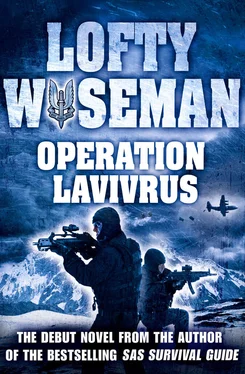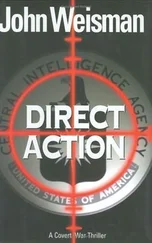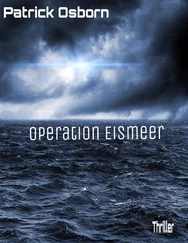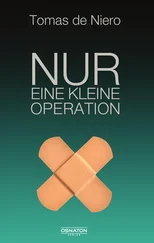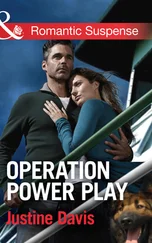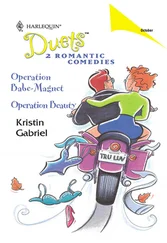He opened the large book on his lap, entitled Jane’s Aircraft Guide, and selected a double-paged pull-out picture of an aircraft that looked menacing even on paper. ‘This, lads, is the Super Etendard. Are you familiar with this aircraft?’
‘I know it’s French and I’ve seen one at Farnborough,’ replied Tony, ‘but that’s all.’ Peter merely nodded and studied the picture before him.
‘Yes, it’s a French strike fighter made by Dassault-Breguet. It’s an old design, but modified extensively. They have a carrier-borne capability, but so far have all been based ashore. It has a new wing, fitted with double slotted flaps, with a drooping leading edge. This is mounted in the mid-fuselage position and swept back at 45 degrees. The tricycle undercarriage is uprated with long-travel shock absorbers for carrier operations.’ All this was reeled off without a glance at the book or reference to any notes. The captain was full of nervous energy and was in his element. ‘The nose wheel is of special importance to you, and we will look at one in the hangar later. The new Atar 9k50 turbojet gives this aircraft an impressive performance: 733 m.p.h. at sea level, 45,000 feet ceiling and a operational combat radius of 528 miles.’
He propped the book open on the desk and used an old whip antenna as a pointer. He indicated different components as he introduced them, tapping the book for emphasis when required. His enthusiasm was infectious, holding the pair’s attention.
‘The armoured cockpit is pressurised and fitted with a Martin Baker lightweight ejection seat. They are all single-seaters, and this is a weak point. With all the sophistication of electronic counter-measures, inertial navigation and weapon systems, it puts too much strain on one man. A second man is desirable. The fuselage is an all-metal semi-monocoque construction, with integral stiffeners. The wings are attached by a two-bar torsion box covered by machined panels.’ A thin bead of sweat formed on his brow, but nothing slowed him down. ‘Now all aircraft are vulnerable on the ground, and you know more about this than I do, but there are several options that we looked at. Considerable damage can be done with a hammer, but this takes too long and is noisy. Obviously explosive does a complete job; it destroys the aircraft, and a timed delay allows the intruders to escape. But what we are trying to achieve has never been done before. We are going to mess with their weapon-aiming systems without the Argies knowing.’ Chas paused to gauge the reaction from his audience.
Tony reflected back to the day he was summoned with Peter into the Ops Room in Hereford and told of the planned incursion onto Argentinian soil. The aim was to neutralise the air threat to the Task Force. The whole operation had to be deniable, which was a contradiction in terms: How could you destroy the threat without leaving any evidence?
The plan was to attack the Super Etendards at their base, not with explosives but with an electronic gadget. To a soldier this was hard to comprehend; he likes to see a mass of burning metal, knowing his job is successful. To infiltrate and leave a device that still allows the aircraft to fly was against his instinct. These electronic devices were untried and involved all the dangers of placement but without the guarantee of success. If they didn’t work there was no second chance.
The operation had to be completely deniable as the British Government would be politically embarrassed by such a venture, and the world would see it as an escalation of the conflict. America had warned of the severe consequences of an invasion of the mainland. Countries sympathetic to Argentina, and those on the fence, could well join the war against Britain.
Captain Minter closed the book and offered them a cigarette. ‘Smoke, anyone?’ he said, offering them a packet of Capstan Full Strength. They both declined, deep in thought as they appreciated what a complicated mission they were engaged in. ‘I didn’t think you would. I’m trying to give up myself,’ he said, flicking open a Zippo lighter with a Special Forces logo on the sides; with a deft flick of the wrist he produced a two-inch flame and lit his cigarette. The resulting clouds of smoke brought the room alive. His desk now took on the look of a battlefield. Tony became agitated and backed away from the smoke, and Chas made a circular motion of his arm, trying to dissipate it.
‘We’ll go in the hangar shortly. It’s a non-smoking zone.’ This was his last chance of a puff, and he was taking full advantage of it. ‘Is there anything I’ve missed?’ he asked, tapping ash into an ashtray made from an artillery shell.
Tony coughed politely into a balled fist and asked, ‘What are the chances of getting away with it? Won’t they get suspicious if they keep missing and find the device?’
Chas answered through a curtain of smoke, exhaling forcefully. ‘Good point, Tony, but the clever thing about the placement is that on the ground it is nowhere near the weapons guidance system. You will see shortly how well it fits in position, and unless they have to service the nose wheel assembly it will go unnoticed. As for the missiles going astray, they will probably think we have developed a new counter-electronic measure. The device is completely passive until activated by the aircraft; it’s not switched on till the aircraft switches on its target acquisition radar.’
He opened up the book again to display the aircraft pull-out, and pointed. ‘The device is planted here on the nose wheel, and it’s only when the undercarriage is retracted that it comes in close proximity to the guidance system. They can only check the aircraft on the ground, so I think we have an excellent chance of getting away with it.’
They both pored over the diagram, noticing the position of the bay that held the electronics of the missile guidance system. It was directly above the recess where the nose wheel was stowed when retracted.
‘You put it in the right place and we will do the rest,’ added Chas between puffs on a rapidly diminishing cig.
‘What about the missile itself?’ enquired Peter. ‘Do we do anything to it?’
‘We have an Exocet in the hangar to show you, and our man, Mr Ford, will brief you on this. He is not available till three, so we will look at the undercarriage first. But in answer to your question, no, you don’t touch anything else. Just place the device in the correct position, and everything else is history,’ he said dramatically, stubbing out the remains of his cigarette. ‘Follow me, gents, and let’s see what we’ve got.’
They retraced their steps down the corridor and went through the large pair of double doors into the hangar. It was a massive structure illuminated by endless rows of fluorescent lights hanging down on chains from the cross-girders that supported the steeply angled roof. The walls were of red brick, giving way to corrugated sheeting at ceiling height, with a pair of huge sliding doors at the far end. The sheeting was painted in a fresh green colour, giving the vast area a pleasant, light atmosphere. The floor was painted red, and in neat rows, as far as the eyes could see, were mortars, artillery pieces, missiles and tanks.
Not many people were allowed in this hangar, and Tony thought the public would love to see this display. It was the best in the country, indeed probably in Europe.
‘This is superb,’ commented Peter. ‘Who uses this lot?’
Chas was leading them to the right between a row of mortars and tanks. He stopped by a multi-barrelled mortar, resting with his left leg up on the base plate with both arms folded over the sights bracket.
‘Basically we study weapon systems here. We obtain weapons and equipment from all around the world and evaluate it. We strip it down, test it and fire it. Most of this kit here is Warsaw Pact, but we look at everything. Anything new, we procure and test.’ Tony and Peter could detect the satisfaction that Peter got from his job, and were impressed by his enthusiasm and knowledge. They felt like rats in a cheese factory.
Читать дальше
